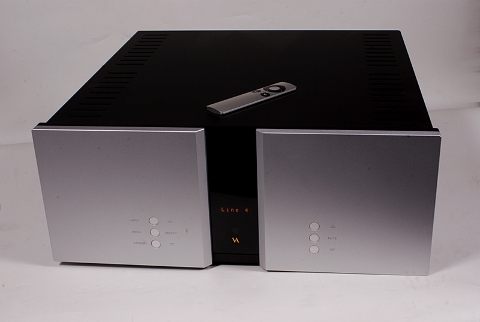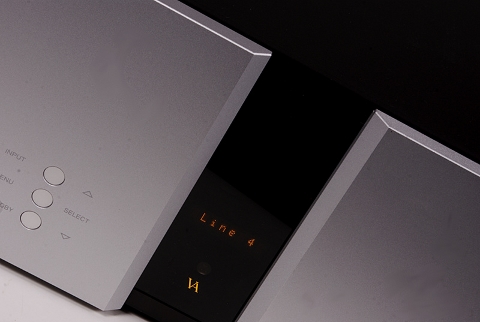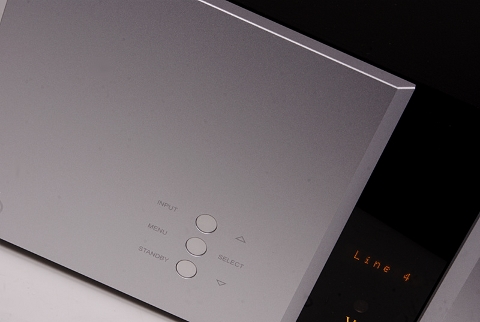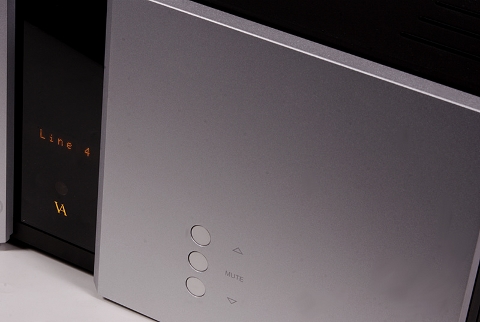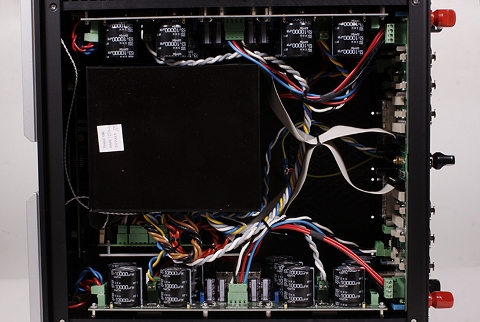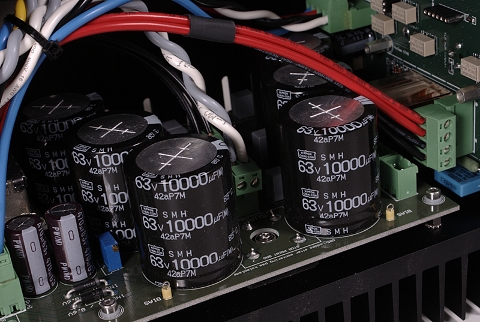about Audio, High Fidelity
& Home Entertainment technologies
pid: 607-2025/10/01 (v1.2)
Privacy Policy

The chassis of the RI-100 follows exactly the main aesthetic norms chosen by the company for all of its products, with a typical "heavy" front panel which includes a dark colored recess featuring a small but quite legible display. The user interface is quite simple and includes six small pressing switches for input selection, volume adjustment and menu navigation. Through the menu, the user can define the name and the sensitivity for each input, whether this input will offer volume adjustment and the way the volume controller acts. There is also a menu-driven input load selector for phono cartridges (if the corresponding module is installed). One can also use the menu to adjust the screen brightness and to select the output function between loudspeakers and headphones, provided that the headphone amplifier is installed. Inputs that are not in use in the present setup can be removed from the input selector sequence.
RI-100 follows the general aesthetics chosen by Vitus for all of its products. Impressive in size (and weight), remains rather simple, with few switches and a legible small display in the center of the front panel.
Vitus has not given, during the writing of this review, detailed information on the various add-on modules and all we know is that the DAC is in its final evaluation phase and it will include a USB port. A very stylish Apple universal remote control provides access to some basic features (on/off, input selection, level adjustment, and muting).
In terms of connectivity, the RI-100 offers a typically good package, which includes a total of five inputs three balanced and two single ended, with one of the later to be sacrificed if the phono preamplifier module is installed. There is a preamp output (balanced, to drive an external power amp or an active subwoofer) and one set of binding posts per channel for loudspeaker connection. The binding posts are of very good quality and ensure easy cable tightening without the use of special tools.
The amplifier displays basic information about user selections (selected input, level, mute, etc.). The name of each input can be modified.
This is a simple and clear-cut user interface: just an input selector, the on/off switch and browse/access buttons for the menu on the left side…
Inside the chassis, one can observe an orderly and rational overall structure with a substantial portion of its volume occupied by the power transformer (an EI conventional design) which is hermetically sealed and decoupled through elastic gaskets. The preamplifier stage is located directly behind the input terminals with the majority of its active part shielded and inaccessible, but it is clear that input selection is done by relays and there is a stepped attenuation network in use for the volume control.
Regarding the latter, the company states that it is designed to introduce a single resistor in the signal path and that each attenuation step uses a different resistor network for optimal operation. Vitus is not very clear in its description but, if one dares to extrapolate, we probably are dealing with a variation of a shunt attenuator, i.e a voltage divider with a constant series resistor and a variable resistor to ground circuit. This design maintains the advantage of the minimum number of parts as in the standard ladder-type attenuator while it requires only one moving electric contact in the signal path.
… level adjustment and the mute switch on the right side. In practice, of course, most of these operations will be controlled through the stylish Apple Remote shown in other photos.
A total of five line-level inputs, a preamp output and two pairs of very good quality binding posts for the loudspeaker cables. At the bottom of the back panel, are two slots which can accommodate modules for a DAC and a headphone amplifier (the red area, below the input/outputs connectors).
To avoid any annoying noises during the volume adjustment, the connection of each new resistor network leads the disconnection of the previous one, creating a side effect, a small - momentary- level fluctuation, as Vitus describes it. In practice, though, you probably need to read this in the instruction manual first and then hear it, as this is a really negligible phenomenon.
The power amplifier circuit features two pairs of power devices per channel (for which the company does not give any additional information). RI-100 uses a separate power supply for each channel (from the rectifiers onward), each including twelve 10.000uF capacitors. Power stage heat sinks are placed inside the chassis which is lined with damping material to reduce mechanical vibrations.
Straightforward construction without any extreme and excessive solutions. Much of the chassis real estate is occupied by the power transformer. Each channel of the power amp stage is in its own board with the power supply on the sides of the chassis, while the preamplifier is positioned near the back panel and the input/output connectors.
This is a part of the input selector. At the bottom of the photograph are the pins where the optional phono preamplifier will be placed if the user chooses to install it.

